Toyota's Leadership and Operational Management: Unit 4 Report Analysis
VerifiedAdded on 2020/07/22
|19
|5966
|32
Report
AI Summary
This report delves into the critical aspects of leadership and operational management within the context of Toyota, a global automobile industry leader. It begins by differentiating the roles and characteristics of modern leaders and managers, exploring how they navigate various situations and make decisions. The report then investigates different leadership theories and models, such as situational and system leadership, and their applications. A significant portion of the report is dedicated to operational management, highlighting its importance in achieving business goals and improving efficiency. Furthermore, the report examines the impact of internal and external factors in the business environment on managerial decision-making. The analysis covers product development, quality maintenance, and sales strategies, providing insights into how leaders and managers at Toyota handle these critical areas. The report concludes by summarizing the key findings and offering a comprehensive understanding of the interplay between leadership, management, and operational success.
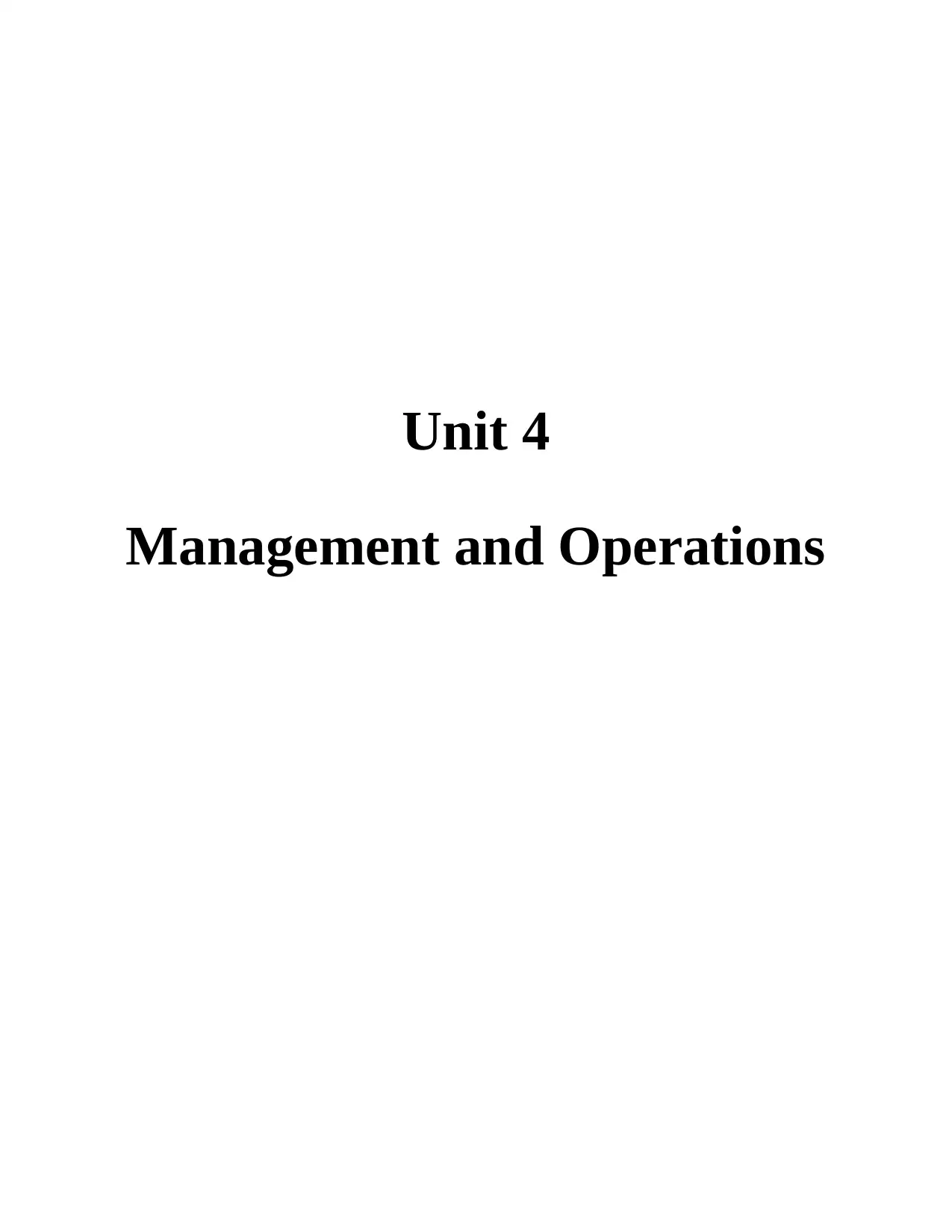
Unit 4
Management and Operations
Management and Operations
Paraphrase This Document
Need a fresh take? Get an instant paraphrase of this document with our AI Paraphraser
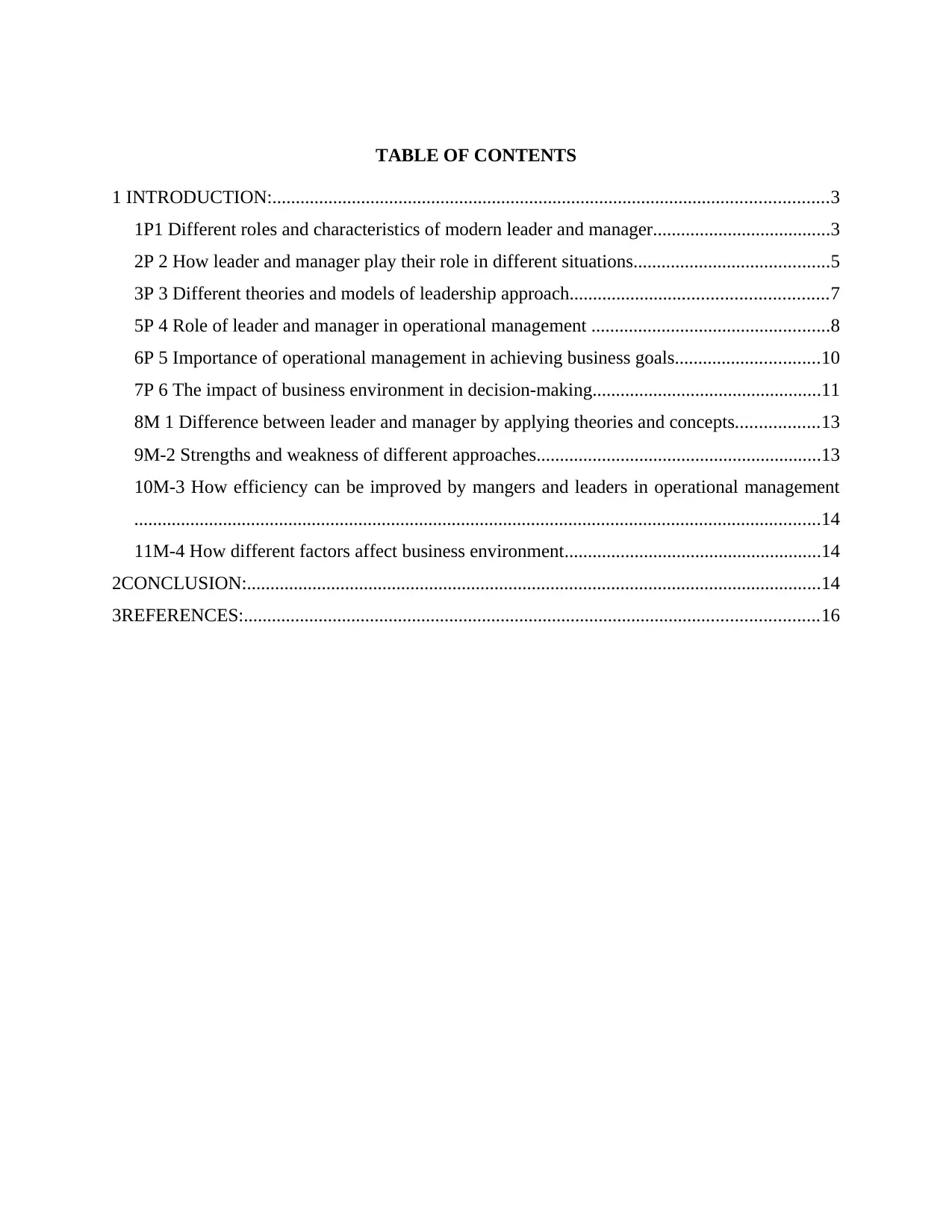
TABLE OF CONTENTS
1 INTRODUCTION:.......................................................................................................................3
1P1 Different roles and characteristics of modern leader and manager......................................3
2P 2 How leader and manager play their role in different situations..........................................5
3P 3 Different theories and models of leadership approach.......................................................7
5P 4 Role of leader and manager in operational management ...................................................8
6P 5 Importance of operational management in achieving business goals...............................10
7P 6 The impact of business environment in decision-making.................................................11
8M 1 Difference between leader and manager by applying theories and concepts..................13
9M-2 Strengths and weakness of different approaches.............................................................13
10M-3 How efficiency can be improved by mangers and leaders in operational management
...................................................................................................................................................14
11M-4 How different factors affect business environment.......................................................14
2CONCLUSION:...........................................................................................................................14
3REFERENCES:...........................................................................................................................16
1 INTRODUCTION:.......................................................................................................................3
1P1 Different roles and characteristics of modern leader and manager......................................3
2P 2 How leader and manager play their role in different situations..........................................5
3P 3 Different theories and models of leadership approach.......................................................7
5P 4 Role of leader and manager in operational management ...................................................8
6P 5 Importance of operational management in achieving business goals...............................10
7P 6 The impact of business environment in decision-making.................................................11
8M 1 Difference between leader and manager by applying theories and concepts..................13
9M-2 Strengths and weakness of different approaches.............................................................13
10M-3 How efficiency can be improved by mangers and leaders in operational management
...................................................................................................................................................14
11M-4 How different factors affect business environment.......................................................14
2CONCLUSION:...........................................................................................................................14
3REFERENCES:...........................................................................................................................16
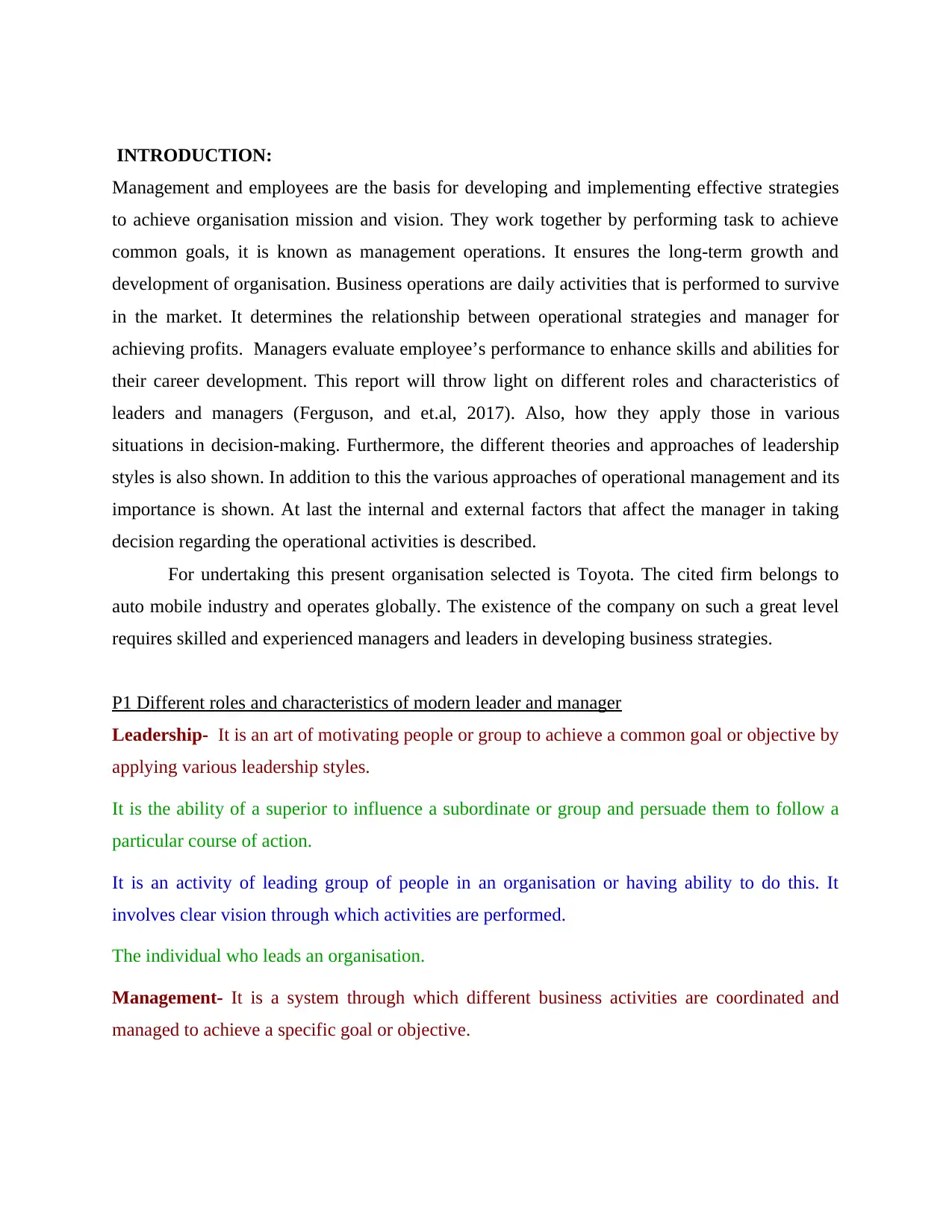
INTRODUCTION:
Management and employees are the basis for developing and implementing effective strategies
to achieve organisation mission and vision. They work together by performing task to achieve
common goals, it is known as management operations. It ensures the long-term growth and
development of organisation. Business operations are daily activities that is performed to survive
in the market. It determines the relationship between operational strategies and manager for
achieving profits. Managers evaluate employee’s performance to enhance skills and abilities for
their career development. This report will throw light on different roles and characteristics of
leaders and managers (Ferguson, and et.al, 2017). Also, how they apply those in various
situations in decision-making. Furthermore, the different theories and approaches of leadership
styles is also shown. In addition to this the various approaches of operational management and its
importance is shown. At last the internal and external factors that affect the manager in taking
decision regarding the operational activities is described.
For undertaking this present organisation selected is Toyota. The cited firm belongs to
auto mobile industry and operates globally. The existence of the company on such a great level
requires skilled and experienced managers and leaders in developing business strategies.
P1 Different roles and characteristics of modern leader and manager
Leadership- It is an art of motivating people or group to achieve a common goal or objective by
applying various leadership styles.
It is the ability of a superior to influence a subordinate or group and persuade them to follow a
particular course of action.
It is an activity of leading group of people in an organisation or having ability to do this. It
involves clear vision through which activities are performed.
The individual who leads an organisation.
Management- It is a system through which different business activities are coordinated and
managed to achieve a specific goal or objective.
Management and employees are the basis for developing and implementing effective strategies
to achieve organisation mission and vision. They work together by performing task to achieve
common goals, it is known as management operations. It ensures the long-term growth and
development of organisation. Business operations are daily activities that is performed to survive
in the market. It determines the relationship between operational strategies and manager for
achieving profits. Managers evaluate employee’s performance to enhance skills and abilities for
their career development. This report will throw light on different roles and characteristics of
leaders and managers (Ferguson, and et.al, 2017). Also, how they apply those in various
situations in decision-making. Furthermore, the different theories and approaches of leadership
styles is also shown. In addition to this the various approaches of operational management and its
importance is shown. At last the internal and external factors that affect the manager in taking
decision regarding the operational activities is described.
For undertaking this present organisation selected is Toyota. The cited firm belongs to
auto mobile industry and operates globally. The existence of the company on such a great level
requires skilled and experienced managers and leaders in developing business strategies.
P1 Different roles and characteristics of modern leader and manager
Leadership- It is an art of motivating people or group to achieve a common goal or objective by
applying various leadership styles.
It is the ability of a superior to influence a subordinate or group and persuade them to follow a
particular course of action.
It is an activity of leading group of people in an organisation or having ability to do this. It
involves clear vision through which activities are performed.
The individual who leads an organisation.
Management- It is a system through which different business activities are coordinated and
managed to achieve a specific goal or objective.
⊘ This is a preview!⊘
Do you want full access?
Subscribe today to unlock all pages.

Trusted by 1+ million students worldwide
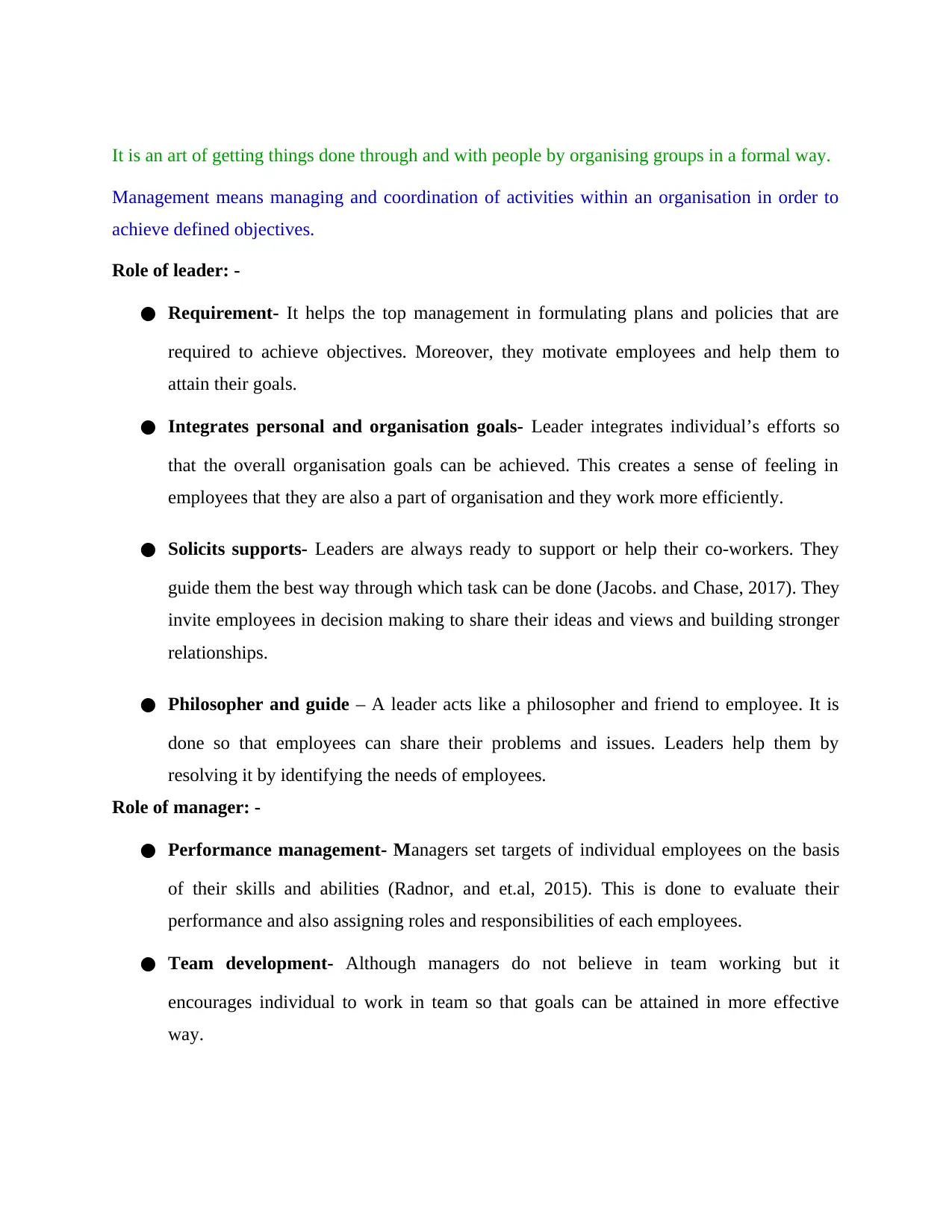
It is an art of getting things done through and with people by organising groups in a formal way.
Management means managing and coordination of activities within an organisation in order to
achieve defined objectives.
Role of leader: -
● Requirement- It helps the top management in formulating plans and policies that are
required to achieve objectives. Moreover, they motivate employees and help them to
attain their goals.
● Integrates personal and organisation goals- Leader integrates individual’s efforts so
that the overall organisation goals can be achieved. This creates a sense of feeling in
employees that they are also a part of organisation and they work more efficiently.
● Solicits supports- Leaders are always ready to support or help their co-workers. They
guide them the best way through which task can be done (Jacobs. and Chase, 2017). They
invite employees in decision making to share their ideas and views and building stronger
relationships.
● Philosopher and guide – A leader acts like a philosopher and friend to employee. It is
done so that employees can share their problems and issues. Leaders help them by
resolving it by identifying the needs of employees.
Role of manager: -
● Performance management- Managers set targets of individual employees on the basis
of their skills and abilities (Radnor, and et.al, 2015). This is done to evaluate their
performance and also assigning roles and responsibilities of each employees.
● Team development- Although managers do not believe in team working but it
encourages individual to work in team so that goals can be attained in more effective
way.
Management means managing and coordination of activities within an organisation in order to
achieve defined objectives.
Role of leader: -
● Requirement- It helps the top management in formulating plans and policies that are
required to achieve objectives. Moreover, they motivate employees and help them to
attain their goals.
● Integrates personal and organisation goals- Leader integrates individual’s efforts so
that the overall organisation goals can be achieved. This creates a sense of feeling in
employees that they are also a part of organisation and they work more efficiently.
● Solicits supports- Leaders are always ready to support or help their co-workers. They
guide them the best way through which task can be done (Jacobs. and Chase, 2017). They
invite employees in decision making to share their ideas and views and building stronger
relationships.
● Philosopher and guide – A leader acts like a philosopher and friend to employee. It is
done so that employees can share their problems and issues. Leaders help them by
resolving it by identifying the needs of employees.
Role of manager: -
● Performance management- Managers set targets of individual employees on the basis
of their skills and abilities (Radnor, and et.al, 2015). This is done to evaluate their
performance and also assigning roles and responsibilities of each employees.
● Team development- Although managers do not believe in team working but it
encourages individual to work in team so that goals can be attained in more effective
way.
Paraphrase This Document
Need a fresh take? Get an instant paraphrase of this document with our AI Paraphraser
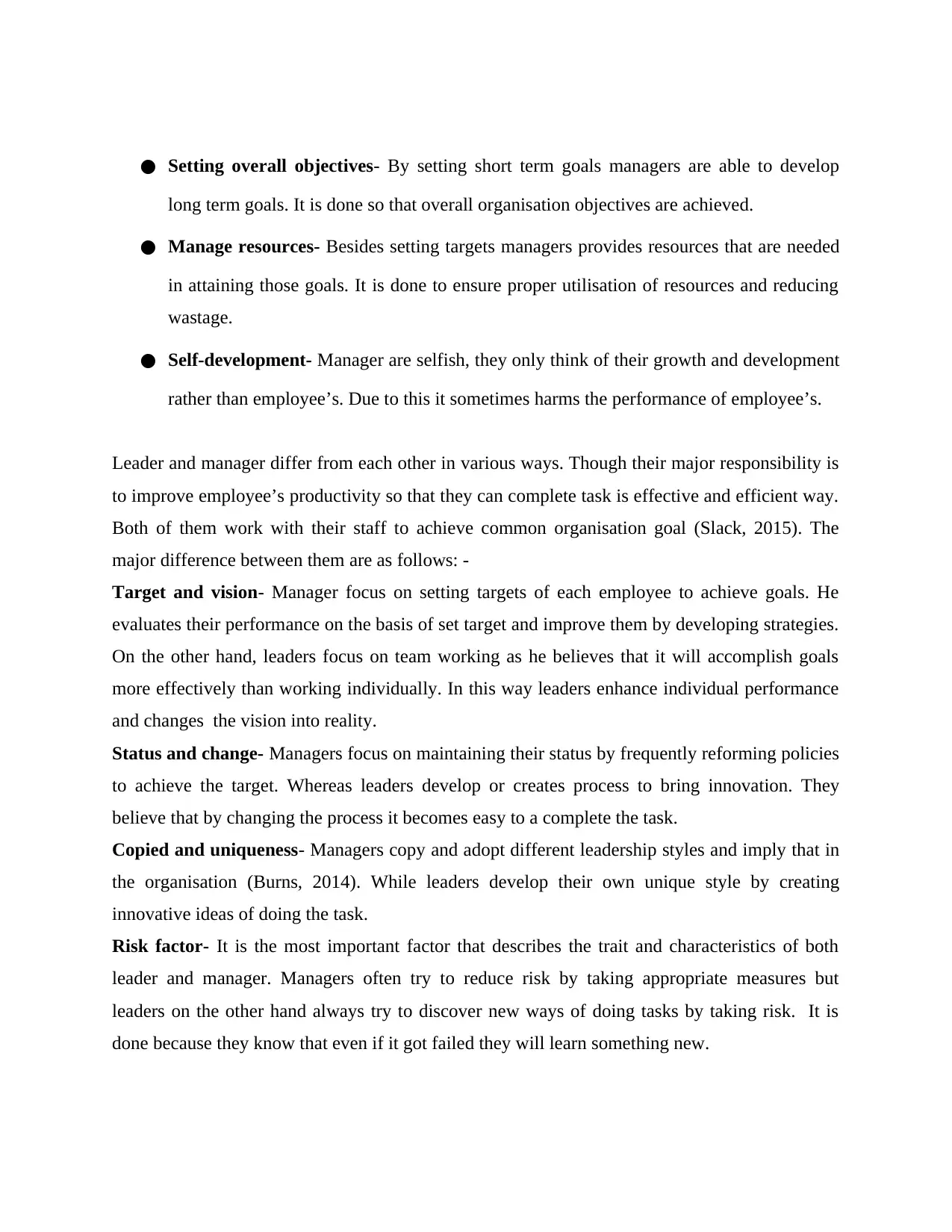
● Setting overall objectives- By setting short term goals managers are able to develop
long term goals. It is done so that overall organisation objectives are achieved.
● Manage resources- Besides setting targets managers provides resources that are needed
in attaining those goals. It is done to ensure proper utilisation of resources and reducing
wastage.
● Self-development- Manager are selfish, they only think of their growth and development
rather than employee’s. Due to this it sometimes harms the performance of employee’s.
Leader and manager differ from each other in various ways. Though their major responsibility is
to improve employee’s productivity so that they can complete task is effective and efficient way.
Both of them work with their staff to achieve common organisation goal (Slack, 2015). The
major difference between them are as follows: -
Target and vision- Manager focus on setting targets of each employee to achieve goals. He
evaluates their performance on the basis of set target and improve them by developing strategies.
On the other hand, leaders focus on team working as he believes that it will accomplish goals
more effectively than working individually. In this way leaders enhance individual performance
and changes the vision into reality.
Status and change- Managers focus on maintaining their status by frequently reforming policies
to achieve the target. Whereas leaders develop or creates process to bring innovation. They
believe that by changing the process it becomes easy to a complete the task.
Copied and uniqueness- Managers copy and adopt different leadership styles and imply that in
the organisation (Burns, 2014). While leaders develop their own unique style by creating
innovative ideas of doing the task.
Risk factor- It is the most important factor that describes the trait and characteristics of both
leader and manager. Managers often try to reduce risk by taking appropriate measures but
leaders on the other hand always try to discover new ways of doing tasks by taking risk. It is
done because they know that even if it got failed they will learn something new.
long term goals. It is done so that overall organisation objectives are achieved.
● Manage resources- Besides setting targets managers provides resources that are needed
in attaining those goals. It is done to ensure proper utilisation of resources and reducing
wastage.
● Self-development- Manager are selfish, they only think of their growth and development
rather than employee’s. Due to this it sometimes harms the performance of employee’s.
Leader and manager differ from each other in various ways. Though their major responsibility is
to improve employee’s productivity so that they can complete task is effective and efficient way.
Both of them work with their staff to achieve common organisation goal (Slack, 2015). The
major difference between them are as follows: -
Target and vision- Manager focus on setting targets of each employee to achieve goals. He
evaluates their performance on the basis of set target and improve them by developing strategies.
On the other hand, leaders focus on team working as he believes that it will accomplish goals
more effectively than working individually. In this way leaders enhance individual performance
and changes the vision into reality.
Status and change- Managers focus on maintaining their status by frequently reforming policies
to achieve the target. Whereas leaders develop or creates process to bring innovation. They
believe that by changing the process it becomes easy to a complete the task.
Copied and uniqueness- Managers copy and adopt different leadership styles and imply that in
the organisation (Burns, 2014). While leaders develop their own unique style by creating
innovative ideas of doing the task.
Risk factor- It is the most important factor that describes the trait and characteristics of both
leader and manager. Managers often try to reduce risk by taking appropriate measures but
leaders on the other hand always try to discover new ways of doing tasks by taking risk. It is
done because they know that even if it got failed they will learn something new.
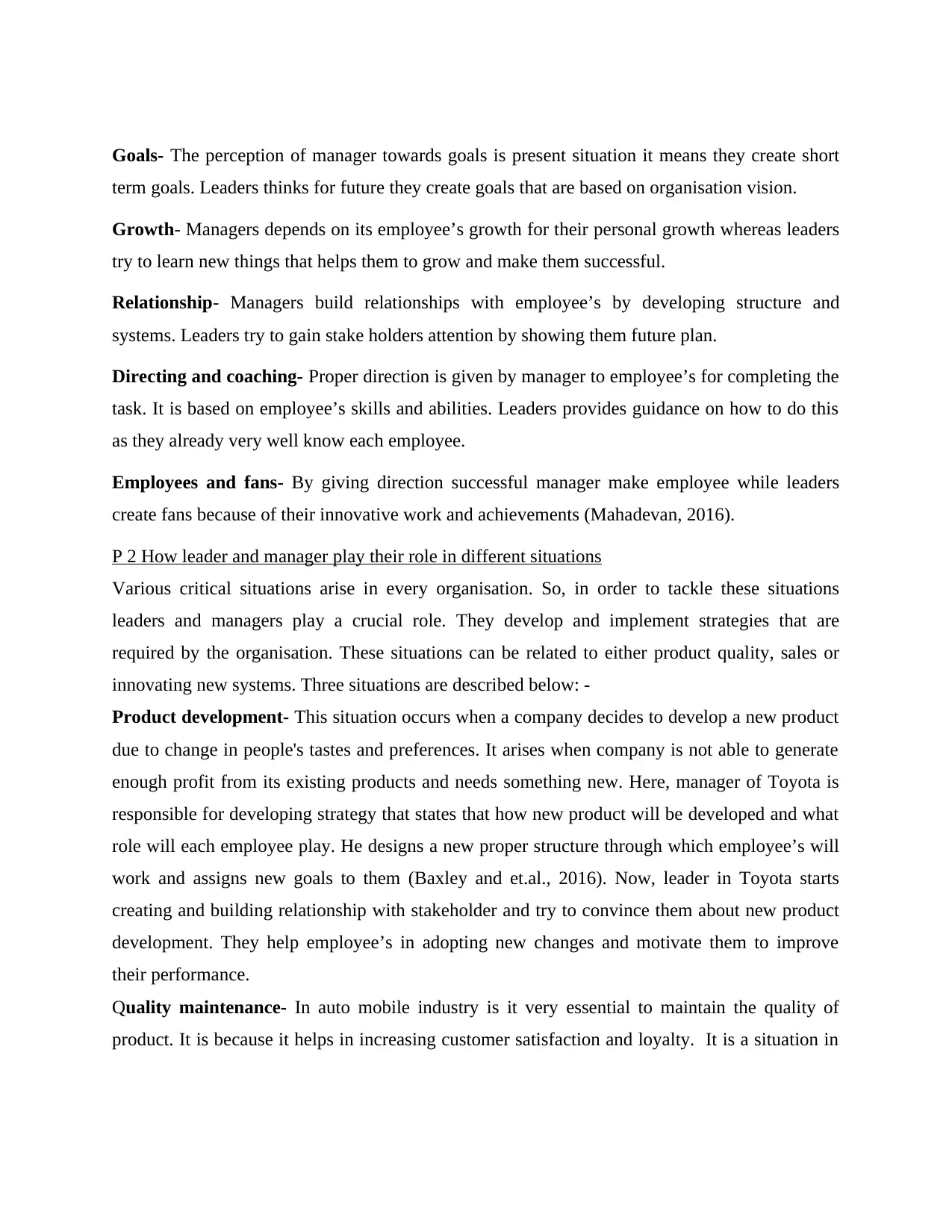
Goals- The perception of manager towards goals is present situation it means they create short
term goals. Leaders thinks for future they create goals that are based on organisation vision.
Growth- Managers depends on its employee’s growth for their personal growth whereas leaders
try to learn new things that helps them to grow and make them successful.
Relationship- Managers build relationships with employee’s by developing structure and
systems. Leaders try to gain stake holders attention by showing them future plan.
Directing and coaching- Proper direction is given by manager to employee’s for completing the
task. It is based on employee’s skills and abilities. Leaders provides guidance on how to do this
as they already very well know each employee.
Employees and fans- By giving direction successful manager make employee while leaders
create fans because of their innovative work and achievements (Mahadevan, 2016).
P 2 How leader and manager play their role in different situations
Various critical situations arise in every organisation. So, in order to tackle these situations
leaders and managers play a crucial role. They develop and implement strategies that are
required by the organisation. These situations can be related to either product quality, sales or
innovating new systems. Three situations are described below: -
Product development- This situation occurs when a company decides to develop a new product
due to change in people's tastes and preferences. It arises when company is not able to generate
enough profit from its existing products and needs something new. Here, manager of Toyota is
responsible for developing strategy that states that how new product will be developed and what
role will each employee play. He designs a new proper structure through which employee’s will
work and assigns new goals to them (Baxley and et.al., 2016). Now, leader in Toyota starts
creating and building relationship with stakeholder and try to convince them about new product
development. They help employee’s in adopting new changes and motivate them to improve
their performance.
Quality maintenance- In auto mobile industry is it very essential to maintain the quality of
product. It is because it helps in increasing customer satisfaction and loyalty. It is a situation in
term goals. Leaders thinks for future they create goals that are based on organisation vision.
Growth- Managers depends on its employee’s growth for their personal growth whereas leaders
try to learn new things that helps them to grow and make them successful.
Relationship- Managers build relationships with employee’s by developing structure and
systems. Leaders try to gain stake holders attention by showing them future plan.
Directing and coaching- Proper direction is given by manager to employee’s for completing the
task. It is based on employee’s skills and abilities. Leaders provides guidance on how to do this
as they already very well know each employee.
Employees and fans- By giving direction successful manager make employee while leaders
create fans because of their innovative work and achievements (Mahadevan, 2016).
P 2 How leader and manager play their role in different situations
Various critical situations arise in every organisation. So, in order to tackle these situations
leaders and managers play a crucial role. They develop and implement strategies that are
required by the organisation. These situations can be related to either product quality, sales or
innovating new systems. Three situations are described below: -
Product development- This situation occurs when a company decides to develop a new product
due to change in people's tastes and preferences. It arises when company is not able to generate
enough profit from its existing products and needs something new. Here, manager of Toyota is
responsible for developing strategy that states that how new product will be developed and what
role will each employee play. He designs a new proper structure through which employee’s will
work and assigns new goals to them (Baxley and et.al., 2016). Now, leader in Toyota starts
creating and building relationship with stakeholder and try to convince them about new product
development. They help employee’s in adopting new changes and motivate them to improve
their performance.
Quality maintenance- In auto mobile industry is it very essential to maintain the quality of
product. It is because it helps in increasing customer satisfaction and loyalty. It is a situation in
⊘ This is a preview!⊘
Do you want full access?
Subscribe today to unlock all pages.

Trusted by 1+ million students worldwide
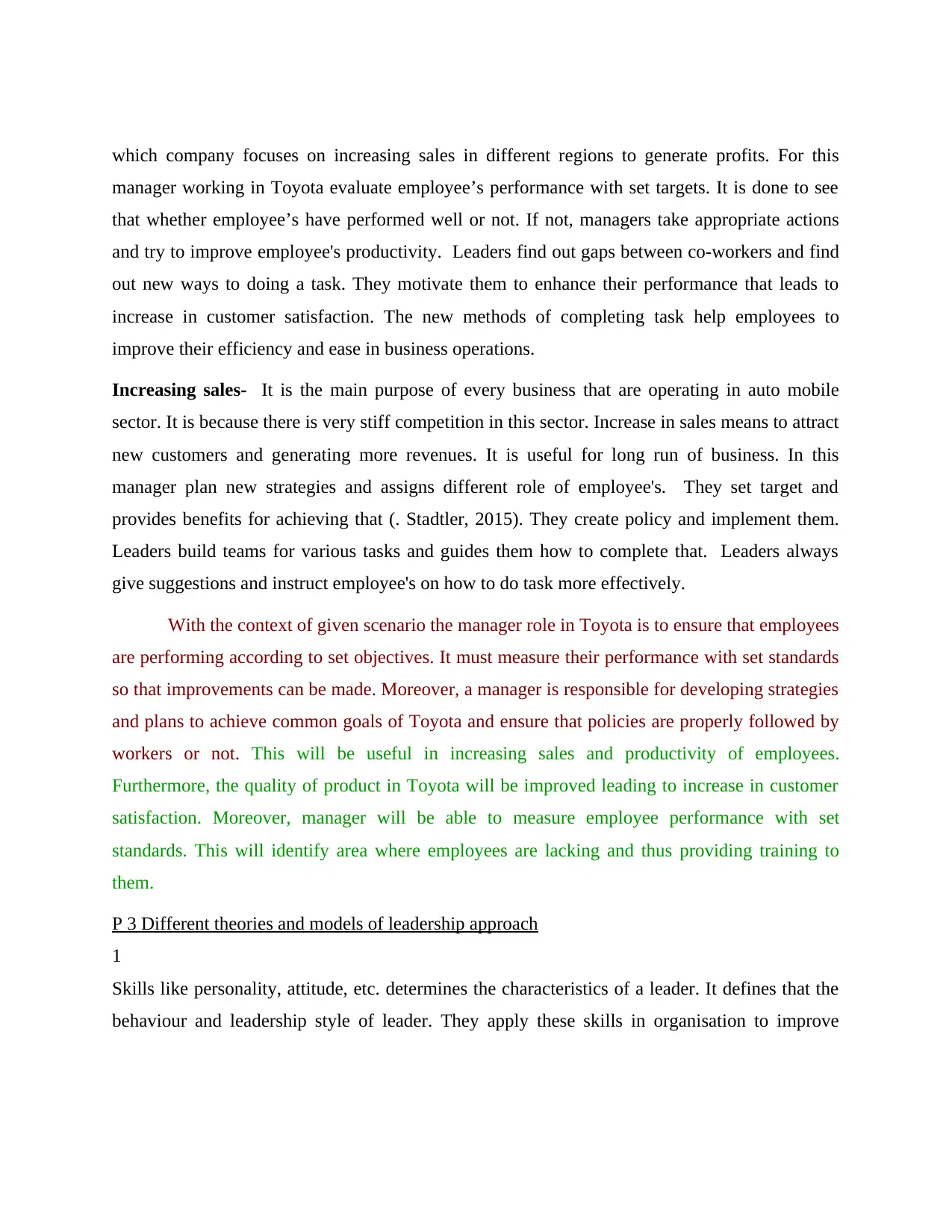
which company focuses on increasing sales in different regions to generate profits. For this
manager working in Toyota evaluate employee’s performance with set targets. It is done to see
that whether employee’s have performed well or not. If not, managers take appropriate actions
and try to improve employee's productivity. Leaders find out gaps between co-workers and find
out new ways to doing a task. They motivate them to enhance their performance that leads to
increase in customer satisfaction. The new methods of completing task help employees to
improve their efficiency and ease in business operations.
Increasing sales- It is the main purpose of every business that are operating in auto mobile
sector. It is because there is very stiff competition in this sector. Increase in sales means to attract
new customers and generating more revenues. It is useful for long run of business. In this
manager plan new strategies and assigns different role of employee's. They set target and
provides benefits for achieving that (. Stadtler, 2015). They create policy and implement them.
Leaders build teams for various tasks and guides them how to complete that. Leaders always
give suggestions and instruct employee's on how to do task more effectively.
With the context of given scenario the manager role in Toyota is to ensure that employees
are performing according to set objectives. It must measure their performance with set standards
so that improvements can be made. Moreover, a manager is responsible for developing strategies
and plans to achieve common goals of Toyota and ensure that policies are properly followed by
workers or not. This will be useful in increasing sales and productivity of employees.
Furthermore, the quality of product in Toyota will be improved leading to increase in customer
satisfaction. Moreover, manager will be able to measure employee performance with set
standards. This will identify area where employees are lacking and thus providing training to
them.
P 3 Different theories and models of leadership approach
1
Skills like personality, attitude, etc. determines the characteristics of a leader. It defines that the
behaviour and leadership style of leader. They apply these skills in organisation to improve
manager working in Toyota evaluate employee’s performance with set targets. It is done to see
that whether employee’s have performed well or not. If not, managers take appropriate actions
and try to improve employee's productivity. Leaders find out gaps between co-workers and find
out new ways to doing a task. They motivate them to enhance their performance that leads to
increase in customer satisfaction. The new methods of completing task help employees to
improve their efficiency and ease in business operations.
Increasing sales- It is the main purpose of every business that are operating in auto mobile
sector. It is because there is very stiff competition in this sector. Increase in sales means to attract
new customers and generating more revenues. It is useful for long run of business. In this
manager plan new strategies and assigns different role of employee's. They set target and
provides benefits for achieving that (. Stadtler, 2015). They create policy and implement them.
Leaders build teams for various tasks and guides them how to complete that. Leaders always
give suggestions and instruct employee's on how to do task more effectively.
With the context of given scenario the manager role in Toyota is to ensure that employees
are performing according to set objectives. It must measure their performance with set standards
so that improvements can be made. Moreover, a manager is responsible for developing strategies
and plans to achieve common goals of Toyota and ensure that policies are properly followed by
workers or not. This will be useful in increasing sales and productivity of employees.
Furthermore, the quality of product in Toyota will be improved leading to increase in customer
satisfaction. Moreover, manager will be able to measure employee performance with set
standards. This will identify area where employees are lacking and thus providing training to
them.
P 3 Different theories and models of leadership approach
1
Skills like personality, attitude, etc. determines the characteristics of a leader. It defines that the
behaviour and leadership style of leader. They apply these skills in organisation to improve
Paraphrase This Document
Need a fresh take? Get an instant paraphrase of this document with our AI Paraphraser
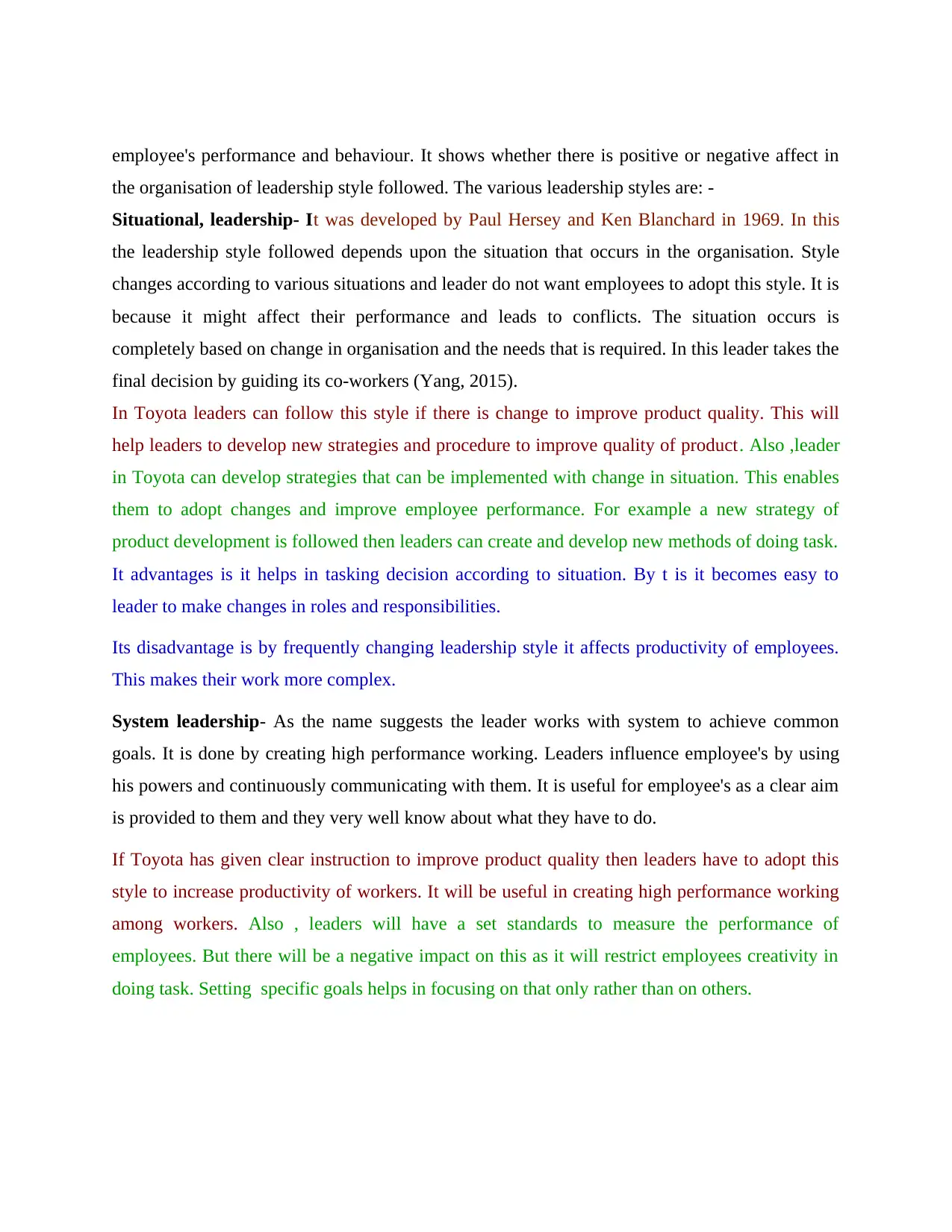
employee's performance and behaviour. It shows whether there is positive or negative affect in
the organisation of leadership style followed. The various leadership styles are: -
Situational, leadership- It was developed by Paul Hersey and Ken Blanchard in 1969. In this
the leadership style followed depends upon the situation that occurs in the organisation. Style
changes according to various situations and leader do not want employees to adopt this style. It is
because it might affect their performance and leads to conflicts. The situation occurs is
completely based on change in organisation and the needs that is required. In this leader takes the
final decision by guiding its co-workers (Yang, 2015).
In Toyota leaders can follow this style if there is change to improve product quality. This will
help leaders to develop new strategies and procedure to improve quality of product. Also ,leader
in Toyota can develop strategies that can be implemented with change in situation. This enables
them to adopt changes and improve employee performance. For example a new strategy of
product development is followed then leaders can create and develop new methods of doing task.
It advantages is it helps in tasking decision according to situation. By t is it becomes easy to
leader to make changes in roles and responsibilities.
Its disadvantage is by frequently changing leadership style it affects productivity of employees.
This makes their work more complex.
System leadership- As the name suggests the leader works with system to achieve common
goals. It is done by creating high performance working. Leaders influence employee's by using
his powers and continuously communicating with them. It is useful for employee's as a clear aim
is provided to them and they very well know about what they have to do.
If Toyota has given clear instruction to improve product quality then leaders have to adopt this
style to increase productivity of workers. It will be useful in creating high performance working
among workers. Also , leaders will have a set standards to measure the performance of
employees. But there will be a negative impact on this as it will restrict employees creativity in
doing task. Setting specific goals helps in focusing on that only rather than on others.
the organisation of leadership style followed. The various leadership styles are: -
Situational, leadership- It was developed by Paul Hersey and Ken Blanchard in 1969. In this
the leadership style followed depends upon the situation that occurs in the organisation. Style
changes according to various situations and leader do not want employees to adopt this style. It is
because it might affect their performance and leads to conflicts. The situation occurs is
completely based on change in organisation and the needs that is required. In this leader takes the
final decision by guiding its co-workers (Yang, 2015).
In Toyota leaders can follow this style if there is change to improve product quality. This will
help leaders to develop new strategies and procedure to improve quality of product. Also ,leader
in Toyota can develop strategies that can be implemented with change in situation. This enables
them to adopt changes and improve employee performance. For example a new strategy of
product development is followed then leaders can create and develop new methods of doing task.
It advantages is it helps in tasking decision according to situation. By t is it becomes easy to
leader to make changes in roles and responsibilities.
Its disadvantage is by frequently changing leadership style it affects productivity of employees.
This makes their work more complex.
System leadership- As the name suggests the leader works with system to achieve common
goals. It is done by creating high performance working. Leaders influence employee's by using
his powers and continuously communicating with them. It is useful for employee's as a clear aim
is provided to them and they very well know about what they have to do.
If Toyota has given clear instruction to improve product quality then leaders have to adopt this
style to increase productivity of workers. It will be useful in creating high performance working
among workers. Also , leaders will have a set standards to measure the performance of
employees. But there will be a negative impact on this as it will restrict employees creativity in
doing task. Setting specific goals helps in focusing on that only rather than on others.
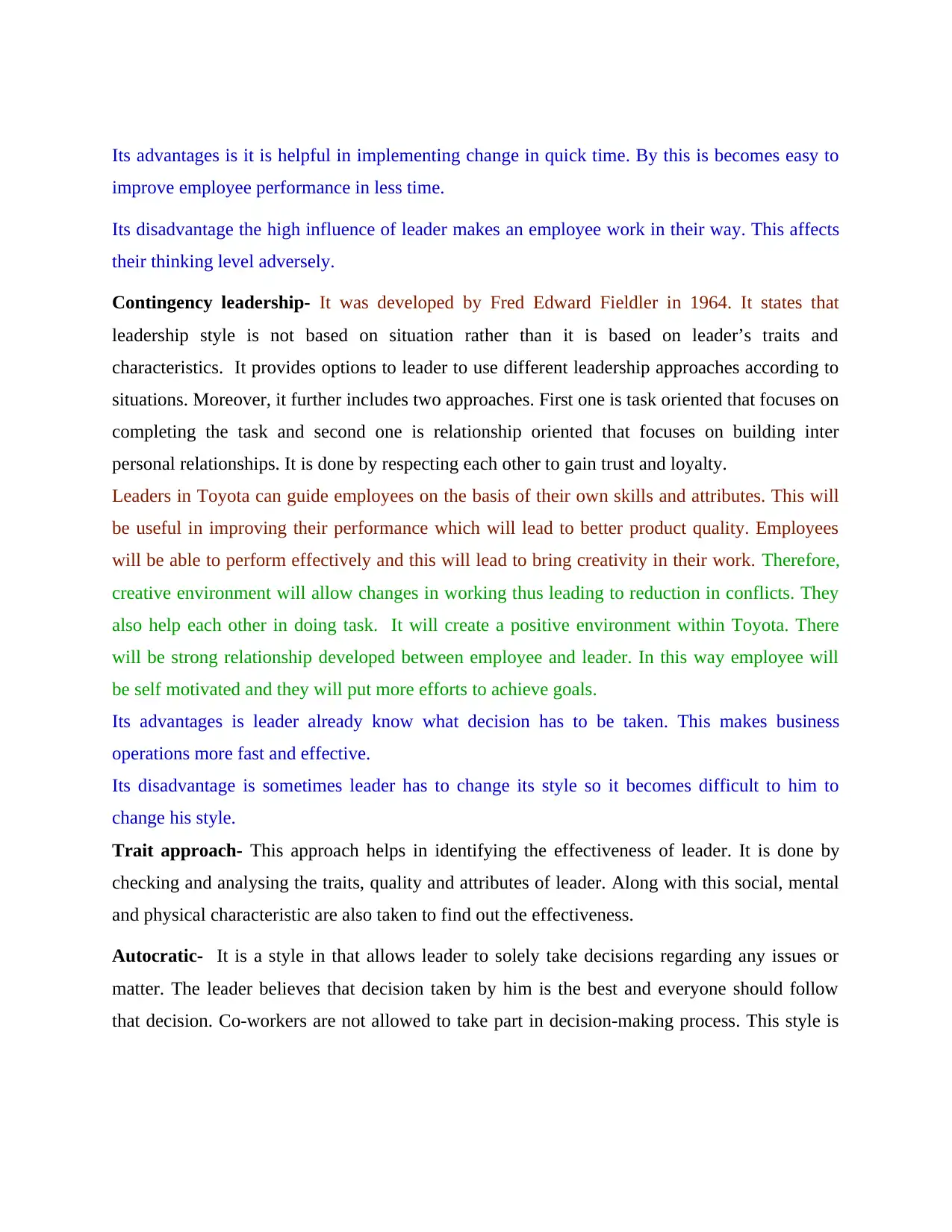
Its advantages is it is helpful in implementing change in quick time. By this is becomes easy to
improve employee performance in less time.
Its disadvantage the high influence of leader makes an employee work in their way. This affects
their thinking level adversely.
Contingency leadership- It was developed by Fred Edward Fieldler in 1964. It states that
leadership style is not based on situation rather than it is based on leader’s traits and
characteristics. It provides options to leader to use different leadership approaches according to
situations. Moreover, it further includes two approaches. First one is task oriented that focuses on
completing the task and second one is relationship oriented that focuses on building inter
personal relationships. It is done by respecting each other to gain trust and loyalty.
Leaders in Toyota can guide employees on the basis of their own skills and attributes. This will
be useful in improving their performance which will lead to better product quality. Employees
will be able to perform effectively and this will lead to bring creativity in their work. Therefore,
creative environment will allow changes in working thus leading to reduction in conflicts. They
also help each other in doing task. It will create a positive environment within Toyota. There
will be strong relationship developed between employee and leader. In this way employee will
be self motivated and they will put more efforts to achieve goals.
Its advantages is leader already know what decision has to be taken. This makes business
operations more fast and effective.
Its disadvantage is sometimes leader has to change its style so it becomes difficult to him to
change his style.
Trait approach- This approach helps in identifying the effectiveness of leader. It is done by
checking and analysing the traits, quality and attributes of leader. Along with this social, mental
and physical characteristic are also taken to find out the effectiveness.
Autocratic- It is a style in that allows leader to solely take decisions regarding any issues or
matter. The leader believes that decision taken by him is the best and everyone should follow
that decision. Co-workers are not allowed to take part in decision-making process. This style is
improve employee performance in less time.
Its disadvantage the high influence of leader makes an employee work in their way. This affects
their thinking level adversely.
Contingency leadership- It was developed by Fred Edward Fieldler in 1964. It states that
leadership style is not based on situation rather than it is based on leader’s traits and
characteristics. It provides options to leader to use different leadership approaches according to
situations. Moreover, it further includes two approaches. First one is task oriented that focuses on
completing the task and second one is relationship oriented that focuses on building inter
personal relationships. It is done by respecting each other to gain trust and loyalty.
Leaders in Toyota can guide employees on the basis of their own skills and attributes. This will
be useful in improving their performance which will lead to better product quality. Employees
will be able to perform effectively and this will lead to bring creativity in their work. Therefore,
creative environment will allow changes in working thus leading to reduction in conflicts. They
also help each other in doing task. It will create a positive environment within Toyota. There
will be strong relationship developed between employee and leader. In this way employee will
be self motivated and they will put more efforts to achieve goals.
Its advantages is leader already know what decision has to be taken. This makes business
operations more fast and effective.
Its disadvantage is sometimes leader has to change its style so it becomes difficult to him to
change his style.
Trait approach- This approach helps in identifying the effectiveness of leader. It is done by
checking and analysing the traits, quality and attributes of leader. Along with this social, mental
and physical characteristic are also taken to find out the effectiveness.
Autocratic- It is a style in that allows leader to solely take decisions regarding any issues or
matter. The leader believes that decision taken by him is the best and everyone should follow
that decision. Co-workers are not allowed to take part in decision-making process. This style is
⊘ This is a preview!⊘
Do you want full access?
Subscribe today to unlock all pages.

Trusted by 1+ million students worldwide
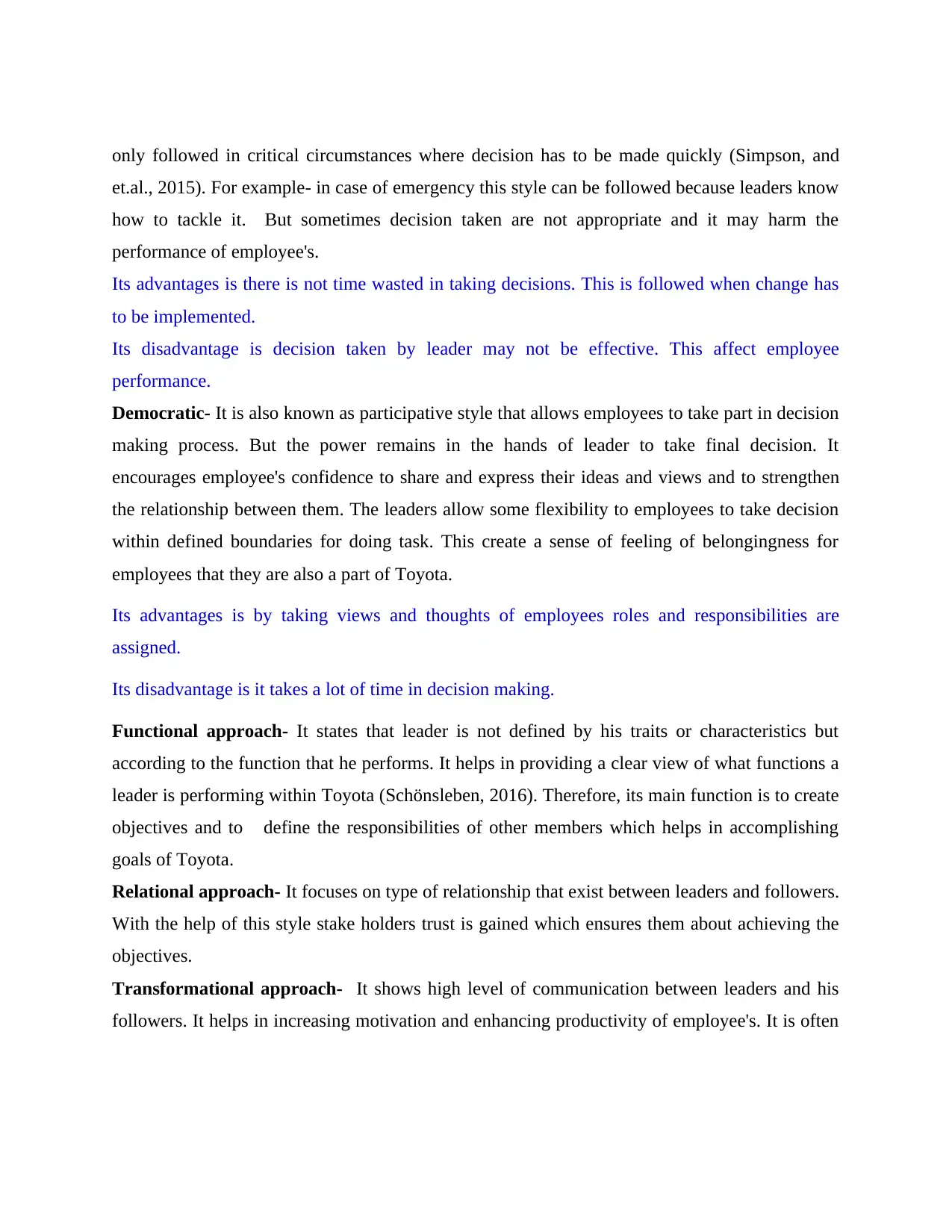
only followed in critical circumstances where decision has to be made quickly (Simpson, and
et.al., 2015). For example- in case of emergency this style can be followed because leaders know
how to tackle it. But sometimes decision taken are not appropriate and it may harm the
performance of employee's.
Its advantages is there is not time wasted in taking decisions. This is followed when change has
to be implemented.
Its disadvantage is decision taken by leader may not be effective. This affect employee
performance.
Democratic- It is also known as participative style that allows employees to take part in decision
making process. But the power remains in the hands of leader to take final decision. It
encourages employee's confidence to share and express their ideas and views and to strengthen
the relationship between them. The leaders allow some flexibility to employees to take decision
within defined boundaries for doing task. This create a sense of feeling of belongingness for
employees that they are also a part of Toyota.
Its advantages is by taking views and thoughts of employees roles and responsibilities are
assigned.
Its disadvantage is it takes a lot of time in decision making.
Functional approach- It states that leader is not defined by his traits or characteristics but
according to the function that he performs. It helps in providing a clear view of what functions a
leader is performing within Toyota (Schönsleben, 2016). Therefore, its main function is to create
objectives and to define the responsibilities of other members which helps in accomplishing
goals of Toyota.
Relational approach- It focuses on type of relationship that exist between leaders and followers.
With the help of this style stake holders trust is gained which ensures them about achieving the
objectives.
Transformational approach- It shows high level of communication between leaders and his
followers. It helps in increasing motivation and enhancing productivity of employee's. It is often
et.al., 2015). For example- in case of emergency this style can be followed because leaders know
how to tackle it. But sometimes decision taken are not appropriate and it may harm the
performance of employee's.
Its advantages is there is not time wasted in taking decisions. This is followed when change has
to be implemented.
Its disadvantage is decision taken by leader may not be effective. This affect employee
performance.
Democratic- It is also known as participative style that allows employees to take part in decision
making process. But the power remains in the hands of leader to take final decision. It
encourages employee's confidence to share and express their ideas and views and to strengthen
the relationship between them. The leaders allow some flexibility to employees to take decision
within defined boundaries for doing task. This create a sense of feeling of belongingness for
employees that they are also a part of Toyota.
Its advantages is by taking views and thoughts of employees roles and responsibilities are
assigned.
Its disadvantage is it takes a lot of time in decision making.
Functional approach- It states that leader is not defined by his traits or characteristics but
according to the function that he performs. It helps in providing a clear view of what functions a
leader is performing within Toyota (Schönsleben, 2016). Therefore, its main function is to create
objectives and to define the responsibilities of other members which helps in accomplishing
goals of Toyota.
Relational approach- It focuses on type of relationship that exist between leaders and followers.
With the help of this style stake holders trust is gained which ensures them about achieving the
objectives.
Transformational approach- It shows high level of communication between leaders and his
followers. It helps in increasing motivation and enhancing productivity of employee's. It is often
Paraphrase This Document
Need a fresh take? Get an instant paraphrase of this document with our AI Paraphraser
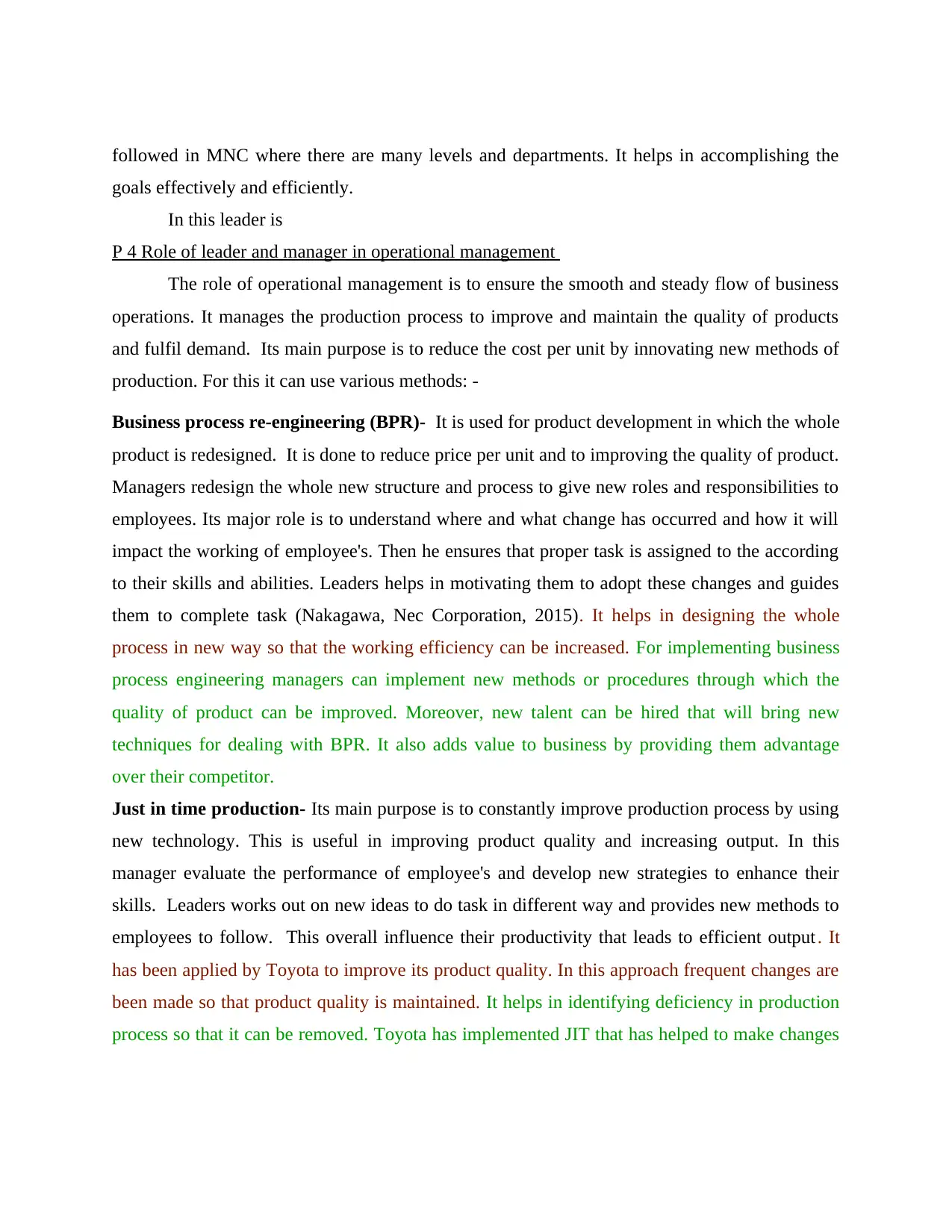
followed in MNC where there are many levels and departments. It helps in accomplishing the
goals effectively and efficiently.
In this leader is
P 4 Role of leader and manager in operational management
The role of operational management is to ensure the smooth and steady flow of business
operations. It manages the production process to improve and maintain the quality of products
and fulfil demand. Its main purpose is to reduce the cost per unit by innovating new methods of
production. For this it can use various methods: -
Business process re-engineering (BPR)- It is used for product development in which the whole
product is redesigned. It is done to reduce price per unit and to improving the quality of product.
Managers redesign the whole new structure and process to give new roles and responsibilities to
employees. Its major role is to understand where and what change has occurred and how it will
impact the working of employee's. Then he ensures that proper task is assigned to the according
to their skills and abilities. Leaders helps in motivating them to adopt these changes and guides
them to complete task (Nakagawa, Nec Corporation, 2015). It helps in designing the whole
process in new way so that the working efficiency can be increased. For implementing business
process engineering managers can implement new methods or procedures through which the
quality of product can be improved. Moreover, new talent can be hired that will bring new
techniques for dealing with BPR. It also adds value to business by providing them advantage
over their competitor.
Just in time production- Its main purpose is to constantly improve production process by using
new technology. This is useful in improving product quality and increasing output. In this
manager evaluate the performance of employee's and develop new strategies to enhance their
skills. Leaders works out on new ideas to do task in different way and provides new methods to
employees to follow. This overall influence their productivity that leads to efficient output. It
has been applied by Toyota to improve its product quality. In this approach frequent changes are
been made so that product quality is maintained. It helps in identifying deficiency in production
process so that it can be removed. Toyota has implemented JIT that has helped to make changes
goals effectively and efficiently.
In this leader is
P 4 Role of leader and manager in operational management
The role of operational management is to ensure the smooth and steady flow of business
operations. It manages the production process to improve and maintain the quality of products
and fulfil demand. Its main purpose is to reduce the cost per unit by innovating new methods of
production. For this it can use various methods: -
Business process re-engineering (BPR)- It is used for product development in which the whole
product is redesigned. It is done to reduce price per unit and to improving the quality of product.
Managers redesign the whole new structure and process to give new roles and responsibilities to
employees. Its major role is to understand where and what change has occurred and how it will
impact the working of employee's. Then he ensures that proper task is assigned to the according
to their skills and abilities. Leaders helps in motivating them to adopt these changes and guides
them to complete task (Nakagawa, Nec Corporation, 2015). It helps in designing the whole
process in new way so that the working efficiency can be increased. For implementing business
process engineering managers can implement new methods or procedures through which the
quality of product can be improved. Moreover, new talent can be hired that will bring new
techniques for dealing with BPR. It also adds value to business by providing them advantage
over their competitor.
Just in time production- Its main purpose is to constantly improve production process by using
new technology. This is useful in improving product quality and increasing output. In this
manager evaluate the performance of employee's and develop new strategies to enhance their
skills. Leaders works out on new ideas to do task in different way and provides new methods to
employees to follow. This overall influence their productivity that leads to efficient output. It
has been applied by Toyota to improve its product quality. In this approach frequent changes are
been made so that product quality is maintained. It helps in identifying deficiency in production
process so that it can be removed. Toyota has implemented JIT that has helped to make changes
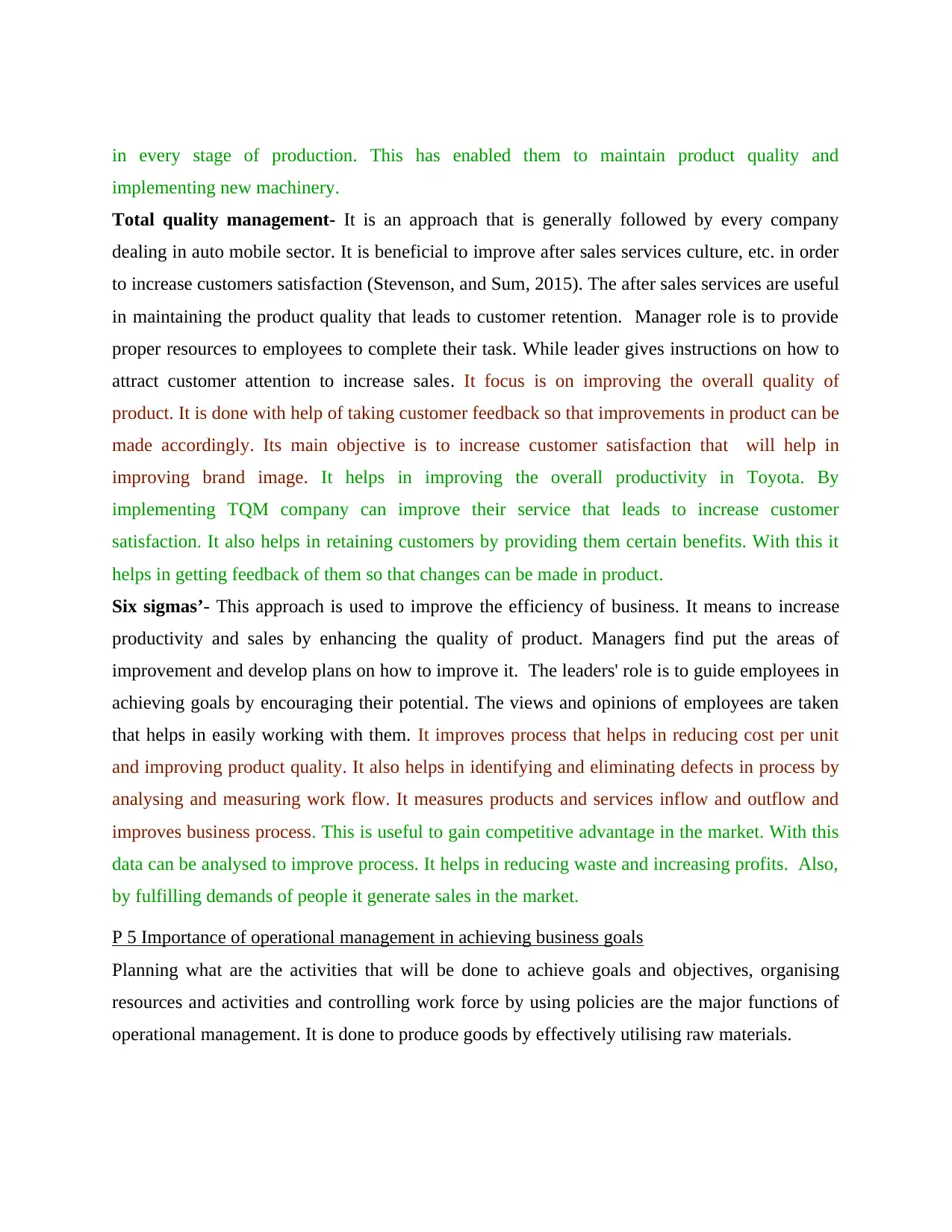
in every stage of production. This has enabled them to maintain product quality and
implementing new machinery.
Total quality management- It is an approach that is generally followed by every company
dealing in auto mobile sector. It is beneficial to improve after sales services culture, etc. in order
to increase customers satisfaction (Stevenson, and Sum, 2015). The after sales services are useful
in maintaining the product quality that leads to customer retention. Manager role is to provide
proper resources to employees to complete their task. While leader gives instructions on how to
attract customer attention to increase sales. It focus is on improving the overall quality of
product. It is done with help of taking customer feedback so that improvements in product can be
made accordingly. Its main objective is to increase customer satisfaction that will help in
improving brand image. It helps in improving the overall productivity in Toyota. By
implementing TQM company can improve their service that leads to increase customer
satisfaction. It also helps in retaining customers by providing them certain benefits. With this it
helps in getting feedback of them so that changes can be made in product.
Six sigmas’- This approach is used to improve the efficiency of business. It means to increase
productivity and sales by enhancing the quality of product. Managers find put the areas of
improvement and develop plans on how to improve it. The leaders' role is to guide employees in
achieving goals by encouraging their potential. The views and opinions of employees are taken
that helps in easily working with them. It improves process that helps in reducing cost per unit
and improving product quality. It also helps in identifying and eliminating defects in process by
analysing and measuring work flow. It measures products and services inflow and outflow and
improves business process. This is useful to gain competitive advantage in the market. With this
data can be analysed to improve process. It helps in reducing waste and increasing profits. Also,
by fulfilling demands of people it generate sales in the market.
P 5 Importance of operational management in achieving business goals
Planning what are the activities that will be done to achieve goals and objectives, organising
resources and activities and controlling work force by using policies are the major functions of
operational management. It is done to produce goods by effectively utilising raw materials.
implementing new machinery.
Total quality management- It is an approach that is generally followed by every company
dealing in auto mobile sector. It is beneficial to improve after sales services culture, etc. in order
to increase customers satisfaction (Stevenson, and Sum, 2015). The after sales services are useful
in maintaining the product quality that leads to customer retention. Manager role is to provide
proper resources to employees to complete their task. While leader gives instructions on how to
attract customer attention to increase sales. It focus is on improving the overall quality of
product. It is done with help of taking customer feedback so that improvements in product can be
made accordingly. Its main objective is to increase customer satisfaction that will help in
improving brand image. It helps in improving the overall productivity in Toyota. By
implementing TQM company can improve their service that leads to increase customer
satisfaction. It also helps in retaining customers by providing them certain benefits. With this it
helps in getting feedback of them so that changes can be made in product.
Six sigmas’- This approach is used to improve the efficiency of business. It means to increase
productivity and sales by enhancing the quality of product. Managers find put the areas of
improvement and develop plans on how to improve it. The leaders' role is to guide employees in
achieving goals by encouraging their potential. The views and opinions of employees are taken
that helps in easily working with them. It improves process that helps in reducing cost per unit
and improving product quality. It also helps in identifying and eliminating defects in process by
analysing and measuring work flow. It measures products and services inflow and outflow and
improves business process. This is useful to gain competitive advantage in the market. With this
data can be analysed to improve process. It helps in reducing waste and increasing profits. Also,
by fulfilling demands of people it generate sales in the market.
P 5 Importance of operational management in achieving business goals
Planning what are the activities that will be done to achieve goals and objectives, organising
resources and activities and controlling work force by using policies are the major functions of
operational management. It is done to produce goods by effectively utilising raw materials.
⊘ This is a preview!⊘
Do you want full access?
Subscribe today to unlock all pages.

Trusted by 1+ million students worldwide
1 out of 19
Related Documents
Your All-in-One AI-Powered Toolkit for Academic Success.
+13062052269
info@desklib.com
Available 24*7 on WhatsApp / Email
![[object Object]](/_next/static/media/star-bottom.7253800d.svg)
Unlock your academic potential
Copyright © 2020–2025 A2Z Services. All Rights Reserved. Developed and managed by ZUCOL.




